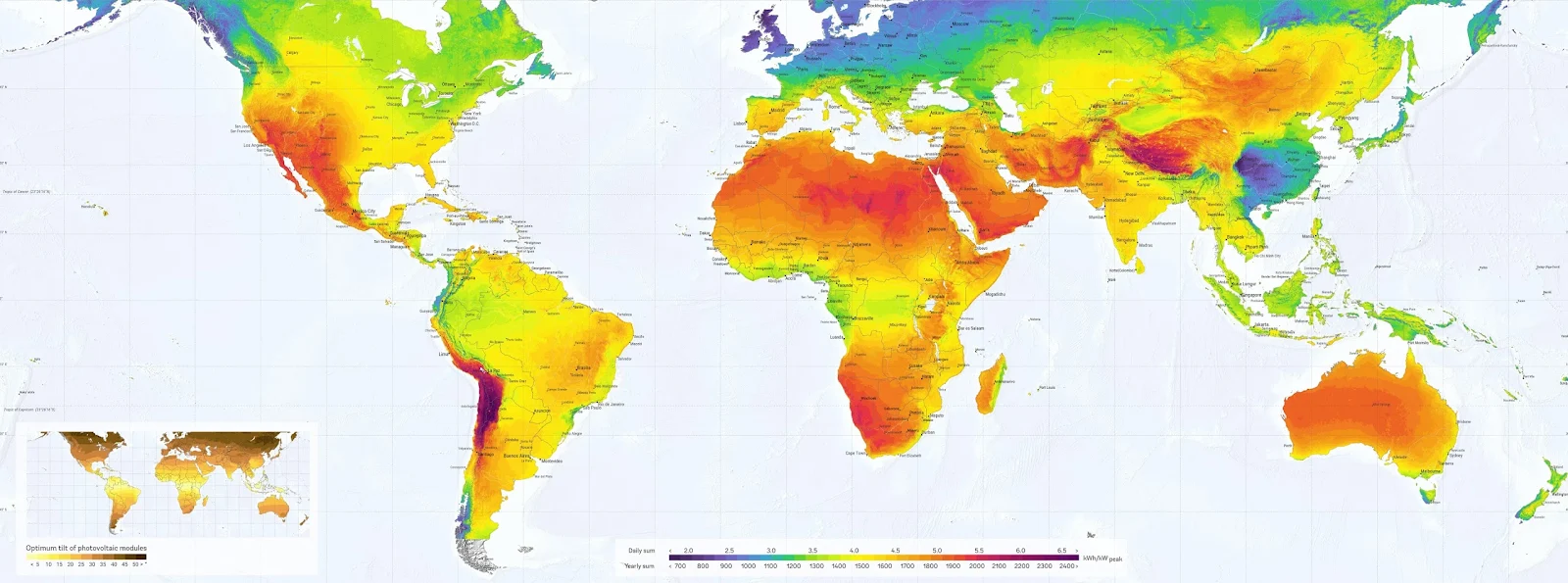The Global Solar Atlas provides a summary of solar power potential and solar resources globally. It is offered as a free service to governments, developers and the general public, and allows users to quickly obtain data and carry out a simple electricity output calculation for any location covered by the solar resource database.
Source globalsolaratlas.info
This map represents average yearly/daily potential electricity production from a 1 kW-peak grid-connected solar photovoltaic (PV) power plant.
The PV system configuration consists of ground-based, free-standing structures with crystalline-silicon PV modules mounted at a fixed position towards the equator, with optimum tilt to maximize yearly energy yield.
Use of high-efficiency inverters is assumed. The solar electricity calculation is based on high-resolution Solargis data and PV modeling software. The model takes into account solar radiation, air temperature, and terrain, to simulate the energy conversion and losses in the PV modules and other components of a PV power plant. The cumulative effect of losses due to dirt, snow and ice on the PV modules, and the losses from cables, inverters and transformers, is 9%. The power plant availability is considered to be 100%.
The Solargis calculation of solar radiation is based on the use of data from five geostationary meteorological satellites (operated by EUMETSAT, NOAA and JMA), and data from global atmospheric and meteorological models (operated by ECMWF and NOAA).
Air temperature is derived from the meteorological models operated by NOAA.
The underlying data is calculated at 10,15 and 30-minute time steps for a period comprising the most recent years, from 1994/1999/2007 (depending on the geographical region) up to the present. The spatial resolution of the grid data in this map is approximately 4 km. The underlying data is available globally, between latitudes 60°N and 45°S, and it is updated in real time. The model performance has been validated by measurements from 200+ high-quality solar monitoring stations. The uncertainty of Solargis yearly values (considering 80% of occurrence) is in the range of ±4 to ±8% for global horizontal irradiation (GHI) and in the range of ±8 to ±15% for direct normal irradiation (DNI).
Via globalsolaratlas.info
Source globalsolaratlas.info
This map represents average yearly/daily potential electricity production from a 1 kW-peak grid-connected solar photovoltaic (PV) power plant.
The PV system configuration consists of ground-based, free-standing structures with crystalline-silicon PV modules mounted at a fixed position towards the equator, with optimum tilt to maximize yearly energy yield.
Use of high-efficiency inverters is assumed. The solar electricity calculation is based on high-resolution Solargis data and PV modeling software. The model takes into account solar radiation, air temperature, and terrain, to simulate the energy conversion and losses in the PV modules and other components of a PV power plant. The cumulative effect of losses due to dirt, snow and ice on the PV modules, and the losses from cables, inverters and transformers, is 9%. The power plant availability is considered to be 100%.
The Solargis calculation of solar radiation is based on the use of data from five geostationary meteorological satellites (operated by EUMETSAT, NOAA and JMA), and data from global atmospheric and meteorological models (operated by ECMWF and NOAA).
Air temperature is derived from the meteorological models operated by NOAA.
The underlying data is calculated at 10,15 and 30-minute time steps for a period comprising the most recent years, from 1994/1999/2007 (depending on the geographical region) up to the present. The spatial resolution of the grid data in this map is approximately 4 km. The underlying data is available globally, between latitudes 60°N and 45°S, and it is updated in real time. The model performance has been validated by measurements from 200+ high-quality solar monitoring stations. The uncertainty of Solargis yearly values (considering 80% of occurrence) is in the range of ±4 to ±8% for global horizontal irradiation (GHI) and in the range of ±8 to ±15% for direct normal irradiation (DNI).
Via globalsolaratlas.info

This post may contain affiliate links. As an Amazon Associate, I earn from qualifying purchases.